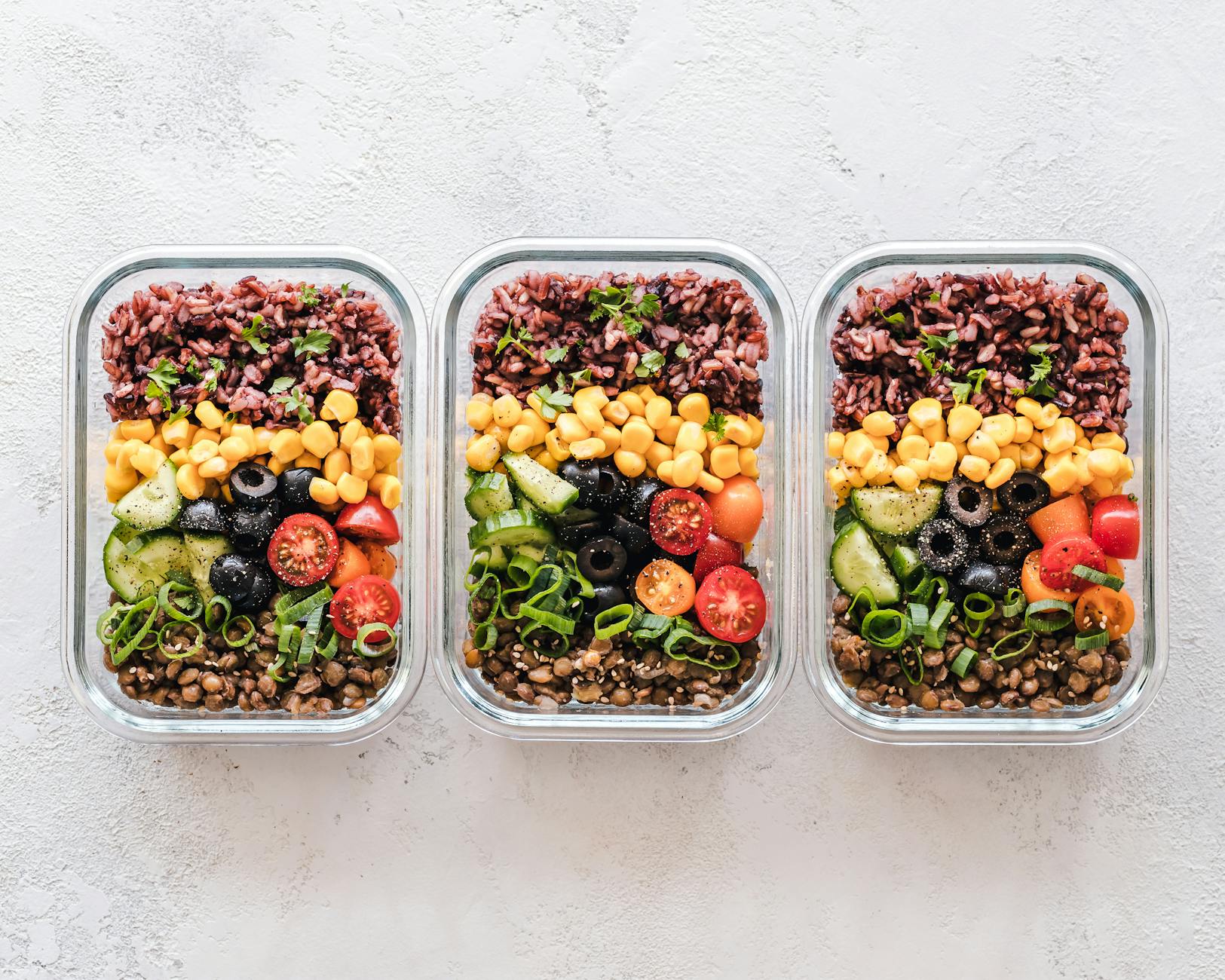Are you tired of one-size-fits-all diets that never seem to work? 🤔 Imagine a nutrition plan tailored specifically to your body, lifestyle, and health goals. That's the power of personalized meal plans. In a world where we customize everything from our smartphones to our streaming services, why settle for generic nutrition advice?
Personalized meal plans are revolutionizing the way we approach health and wellness. Whether you're aiming to lose weight, build muscle, manage a health condition, or simply feel more energized, a customized nutrition strategy can be your secret weapon. But how do you create a plan that's perfect for you? And more importantly, how do you stick to it? 🍽️💪
In this blog post, we'll dive deep into the world of personalized meal plans. We'll explore how to assess your health goals, create a customized plan, and implement it for success. From leveraging technology to overcoming common challenges, we'll equip you with all the tools you need to achieve your health goals through tailored nutrition. Let's embark on this journey to a healthier, happier you!
Understanding Personalized Meal Plans

A. Definition and benefits
Personalized meal plans are tailored nutrition strategies designed to meet an individual's unique dietary needs, preferences, and health goals. These customized approaches offer numerous benefits:
- Improved nutrient intake
- Better adherence to dietary goals
- Enhanced weight management
- Increased energy levels
- Reduced risk of chronic diseases
| Benefit | Description |
|---|---|
| Tailored Nutrition | Addresses specific dietary requirements |
| Goal Alignment | Supports personal health objectives |
| Increased Satisfaction | Incorporates food preferences |
| Better Results | Optimizes nutrient intake for desired outcomes |
B. How they differ from generic diets
Unlike one-size-fits-all diets, personalized meal plans take into account:
- Individual metabolic rates
- Food allergies and intolerances
- Lifestyle factors (e.g., work schedule, physical activity)
- Personal taste preferences
- Cultural and ethical considerations
This personalized approach leads to more sustainable and enjoyable dietary changes, increasing the likelihood of long-term success.
C. Key components of a personalized plan
A comprehensive personalized meal plan typically includes:
- Calorie and macronutrient targets
- Specific food recommendations
- Meal timing suggestions
- Portion size guidance
- Flexibility for dining out or special occasions
These components work together to create a holistic nutrition strategy that aligns with your unique needs and lifestyle. By addressing individual factors, personalized meal plans offer a more effective and sustainable approach to achieving health goals compared to generic diets.
Assessing Your Health Goals
A. Identifying specific objectives
When it comes to personalized meal plans, identifying your specific health objectives is crucial. These goals can range from weight loss to muscle gain, improved energy levels, or managing chronic conditions. To help you narrow down your objectives, consider the following list:
- Weight management (loss, gain, or maintenance)
- Muscle building and strength
- Improved cardiovascular health
- Better digestion and gut health
- Enhanced athletic performance
- Managing chronic conditions (e.g., diabetes, hypertension)
- Increased energy and mental clarity
Once you've identified your primary goals, prioritize them based on importance and urgency. This will help guide the creation of your personalized meal plan.
B. Considering dietary restrictions and preferences
Your meal plan should accommodate any dietary restrictions or preferences you may have. These can include:
| Dietary Consideration | Examples |
|---|---|
| Food allergies | Nuts, shellfish, dairy |
| Intolerances | Lactose, gluten |
| Ethical choices | Vegetarian, vegan |
| Religious restrictions | Kosher, halal |
| Personal preferences | Low-carb, paleo, Mediterranean |
By clearly defining these restrictions and preferences, you ensure that your personalized meal plan is not only effective but also enjoyable and sustainable in the long term.
C. Factoring in lifestyle and activity level
Your daily routine and physical activity play a significant role in determining your nutritional needs. Consider the following aspects:
- Work schedule (e.g., 9-5, shift work, travel)
- Exercise frequency and intensity
- Sedentary vs. active job
- Stress levels and sleep patterns
These factors influence your caloric needs, macronutrient balance, and meal timing. For instance, an athlete training for a marathon will have different nutritional requirements compared to someone with a desk job looking to lose weight.
Now that we've assessed your health goals, let's move on to creating your customized meal plan that aligns with these objectives and considerations.
Creating Your Customized Meal Plan

Calculating calorie needs
To create an effective personalized meal plan, the first step is determining your daily calorie needs. This varies based on factors such as age, gender, height, weight, and activity level. Here's a simple method to estimate your calorie requirements:
- Calculate your Basal Metabolic Rate (BMR)
- Determine your Total Daily Energy Expenditure (TDEE)
- Adjust based on your health goals
| Activity Level | Multiplier |
|---|---|
| Sedentary | 1.2 |
| Lightly Active | 1.375 |
| Moderately Active | 1.55 |
| Very Active | 1.725 |
| Extra Active | 1.9 |
Multiply your BMR by the appropriate activity level multiplier to get your TDEE. Then, adjust this number based on your goals: subtract 500 calories for weight loss or add 300-500 for weight gain.
Balancing macronutrients
Once you've determined your calorie needs, it's crucial to balance your macronutrients - proteins, carbohydrates, and fats. A general guideline for a balanced diet is:
- Proteins: 10-35% of total calories
- Carbohydrates: 45-65% of total calories
- Fats: 20-35% of total calories
Incorporating micronutrients
Micronutrients are essential for optimal health. Ensure your meal plan includes a variety of fruits, vegetables, whole grains, and lean proteins to cover your vitamin and mineral needs. Consider these tips:
- Eat a rainbow of fruits and vegetables
- Include whole grains for B vitamins and fiber
- Choose lean proteins for iron and zinc
- Incorporate healthy fats for fat-soluble vitamins
Meal timing and frequency
The timing and frequency of your meals can significantly impact your health goals. Consider the following:
- Eat every 3-4 hours to maintain stable blood sugar levels
- Include a protein source with each meal to promote satiety
- Plan for pre and post-workout nutrition if you exercise regularly
- Consider intermittent fasting if it aligns with your goals and lifestyle
Now that we've covered the key aspects of creating your customized meal plan, let's explore how to implement it effectively for long-term success.
Implementing Your Plan for Success

Grocery shopping strategies
When implementing your personalized meal plan, smart grocery shopping is key. Here are some effective strategies:
- Plan your meals and create a detailed shopping list
- Shop the perimeter of the store for fresh, whole foods
- Read nutrition labels carefully
- Buy in bulk for staple items
- Choose seasonal produce for better nutrition and cost-effectiveness
| Strategy | Benefit |
|---|---|
| Meal planning | Reduces impulse purchases and food waste |
| Perimeter shopping | Focuses on nutrient-dense, unprocessed foods |
| Label reading | Ensures alignment with your meal plan goals |
| Bulk buying | Saves money and reduces packaging waste |
| Seasonal produce | Provides peak nutrition and flavor |
Meal prep techniques
Efficient meal prep can save time and ensure adherence to your personalized plan:
- Batch cook staples like grains, proteins, and roasted vegetables
- Use portion-controlled containers for easy grab-and-go meals
- Prep ingredients in advance (e.g., chopping vegetables, marinating proteins)
- Utilize your freezer for make-ahead meals and leftovers
Adapting recipes to fit your plan
Customizing recipes to align with your personalized meal plan is crucial:
- Substitute ingredients to match your nutritional needs
- Adjust portion sizes to fit your caloric requirements
- Add or reduce specific macronutrients as needed
- Experiment with herbs and spices to enhance flavors without adding calories
Dealing with dining out and social situations
Maintaining your plan while socializing can be challenging but not impossible:
- Research menus in advance and plan your order
- Don't be afraid to make special requests or modifications
- Practice portion control by sharing dishes or taking leftovers home
- Focus on socializing rather than food during gatherings
Now that you have strategies for implementing your personalized meal plan, let's explore how to track your progress and make necessary adjustments.
Tracking Progress and Adjusting

Monitoring weight and body composition
Tracking your progress is crucial when following a personalized meal plan. Start by monitoring your weight and body composition regularly:
- Weekly weigh-ins
- Monthly body measurements
- Quarterly body fat percentage checks
| Metric | Frequency | Tools |
|---|---|---|
| Weight | Weekly | Digital scale |
| Body measurements | Monthly | Measuring tape |
| Body fat percentage | Quarterly | Calipers or DEXA scan |
Assessing energy levels and performance
Pay attention to how your meal plan affects your daily energy and overall performance:
- Keep a daily energy journal
- Track workout performance
- Note sleep quality and duration
Fine-tuning your meal plan
As you progress, you may need to adjust your meal plan to continue seeing results:
- Reassess calorie intake every 2-4 weeks
- Adjust macronutrient ratios based on energy levels
- Incorporate new foods to prevent boredom
Overcoming plateaus
Plateaus are common in any health journey. Here are strategies to break through:
- Increase protein intake
- Implement intermittent fasting
- Add high-intensity interval training (HIIT)
- Reduce stress through meditation or yoga
Now that you know how to track and adjust your personalized meal plan, let's explore the technology and tools that can support your nutrition journey.
Technology and Tools for Personalized Nutrition

Meal planning apps and software
In the digital age, personalized nutrition has become more accessible through various meal planning apps and software. These tools offer a range of features to help you achieve your health goals:
- Customized meal suggestions
- Grocery list generation
- Nutrition tracking
- Recipe databases
Here's a comparison of popular meal planning apps:
| App Name | Key Features | Personalization Level |
|---|---|---|
| MyFitnessPal | Extensive food database, barcode scanner | Moderate |
| Mealime | Recipe suggestions, automated grocery lists | High |
| PlateJoy | Tailored meal plans, considers dietary restrictions | Very High |
Fitness trackers and their role
Fitness trackers play a crucial role in personalized nutrition by:
- Monitoring physical activity
- Tracking calorie expenditure
- Analyzing sleep patterns
- Integrating with meal planning apps
These devices provide valuable data that can be used to adjust your meal plan based on your daily energy needs and activity levels.
DNA testing for nutrition insights
DNA testing has revolutionized personalized nutrition by offering insights into:
- Genetic predispositions to certain nutrients
- Food sensitivities
- Metabolic factors affecting weight management
This information allows for highly tailored meal plans that consider your unique genetic makeup. Companies like 23andMe and Nutrigenomix offer specialized nutrition-focused genetic testing services.
By leveraging these technological tools, you can create a truly personalized approach to nutrition that aligns with your specific health goals and genetic profile. As we move forward, we'll explore some common challenges you might face when implementing your personalized meal plan and strategies to overcome them.
Common Challenges and How to Overcome Them
A. Staying motivated
Maintaining motivation is crucial for long-term success with personalized meal plans. Here are some effective strategies to keep you inspired:
- Set realistic, achievable goals
- Celebrate small victories along the way
- Find an accountability partner or join a support group
- Visualize your end goal and the benefits of sticking to your plan
| Motivation Strategy | Description | Benefits |
|---|---|---|
| Goal Setting | Break down larger goals into smaller, manageable milestones | Provides a sense of progress and achievement |
| Reward System | Create a reward system for reaching your goals | Reinforces positive behavior and increases motivation |
| Progress Tracking | Use apps or journals to track your progress | Visually demonstrates improvements and encourages consistency |
B. Handling cravings and emotional eating
Cravings and emotional eating can derail even the best-laid meal plans. To overcome these challenges:
- Identify your triggers (stress, boredom, social situations)
- Practice mindful eating techniques
- Find healthy alternatives to satisfy cravings
- Develop coping mechanisms for emotional stress that don't involve food
C. Balancing nutrition with busy schedules
For those with hectic lifestyles, maintaining a balanced diet can be challenging. Try these time-saving tips:
- Meal prep in advance
- Keep healthy snacks readily available
- Utilize slow cookers or instant pots for quick, nutritious meals
- Learn simple, quick recipes that align with your meal plan
D. Dealing with setbacks
Setbacks are a normal part of any health journey. To bounce back:
- Don't dwell on mistakes; learn from them
- Reassess your goals and adjust if necessary
- Seek support from your accountability partner or nutritionist
- Remember that progress isn't linear; focus on overall trends
Now that we've addressed common challenges, let's explore how technology and tools can further enhance your personalized nutrition journey.
Personalized meal plans offer a powerful approach to achieving your health goals, tailoring nutrition to your unique needs and preferences. By assessing your objectives, creating a customized plan, and implementing it with consistency, you can make significant strides towards improved well-being. Regular tracking and adjustments ensure your plan evolves with your progress, while leveraging technology and tools can simplify the process and enhance your results.
Remember, challenges are a natural part of any lifestyle change. By anticipating common obstacles and preparing strategies to overcome them, you'll be better equipped to stay on track. Embrace the journey of personalized nutrition, and you'll not only reach your health goals but also develop sustainable habits for long-term wellness. Take the first step today by creating your personalized meal plan and commit to nourishing your body in a way that's uniquely tailored to you.
